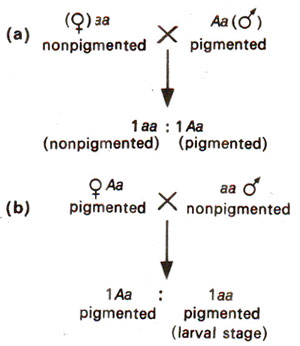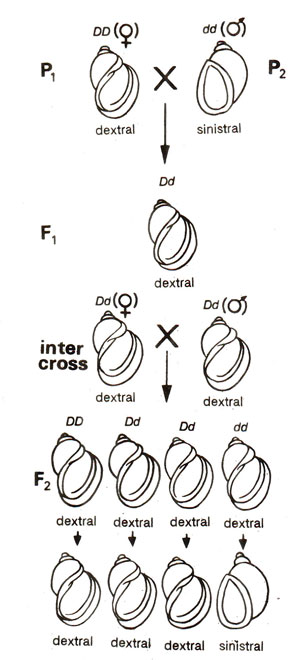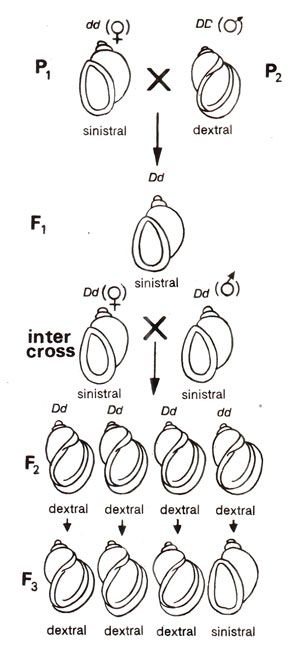
Fig. 18.2. Results of reciprocal croses (♀ non-pigmented aa x ♂ pigmented Aa; ♀ pigmented Aa x ♂ non-pigmented aa) in flour moth (Ephestia kuhniella) showing inheritance of pigment colour.
Pigment in flour moth (Ephestia kuhniella)
A distinct case of maternal effect was discovered in flour moth
{Ephestia kuhniella)by
Caspari (1936). Dark brown eyes and presence of pigment in other parts of the body in this moth are controlled by a dominant gene
A, responsible for production of a pigment precursor
kynurenine. Homozygous recessive
aa lacks kynurenine, so that it exhibits absence of pigment and the eyes therefore have red colour. When heterozygote
Aa (pigmented) is crossed to non pigmented homozygous recessive
aa (
aa ♀
x Aa ♂), as expected, progeny segregates 1
Aa : 1
aa, which phenotypically gives the ratio 1 pigmented : 1 non-pigmented.
In the reciprocal cross, pigmented
Aa (♀) x non-pigmented
aa (♂), the progeny
{lAa : 1
aa) had all the early larvae pigmented. In this case, however, when larvae ' matured, only half of them
{Aa)were dark brown eyed, the other half (
aa) were red eyed (Fig. 18.2). These homozygous (
aa)pigmented larvae received their egg cytoplasm from mother (
Aa) and, therefore, had
kynurenine in early stages of development, but they were incapable of synthesizing their own
kynurenine in the absence of dominant allele and hence loss of pigment in adult moth.

Fig. 18.2. Results of reciprocal croses (♀ non-pigmented aa x ♂ pigmented Aa; ♀ pigmented Aa x ♂ non-pigmented aa) in flour moth (Ephestia kuhniella) showing inheritance of pigment colour.
Coiling of shell in snail (Limnaea peregra)
In snails, coiling of shell can be dextral (coiling to the right) or sinistral (coiling to the left). This direction of coiling is genetically controlled, the dextral-coiling depending upon dominant allele
D and sinistral coiling depending upon recessive-allele
d, so that dextral is
DD and sinistral is
dd.
The phenotype in progeny obtained from reciprocal crosses (♀
DD x ♂
dd : ♀
dd x ♂
DD)is determined by the genotype and not by the phenotype of female parent. In reciprocal crosses shown in Figures 18.3 and 18.4, it is evident that the genotype
Dd (F
1 can be dextral (Fig. 18.3) as well as sinistral (Fig. 18.4) depending upon the genotype of female parent. Similarly,
dd can be dextral if genotype of female parent carries dominant allele (
Dd)
. It should be carefully noted that phenotype of female parent does not have any effect on phenotype of progeny. It is the genotype of female parent which is really decisive. This is an example of delayed effect of genotype.

Fig. 18.3. Results in F1, F2 and F3 from a cross between ♀ dextral (DD)and ♂ sinistral (dd)snails.

Fig. 18.4. Results in F1, F2 and F3 from a cross between ♀ sinistral (dd)and ♂ dextral (DD)snails.








